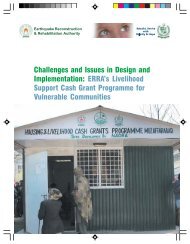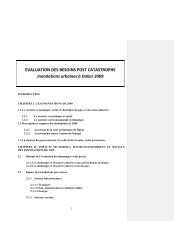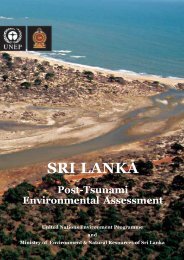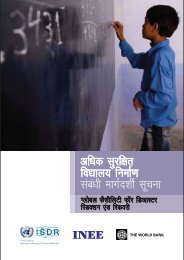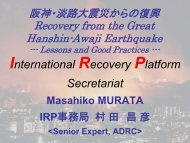KNOWLEDGE NOTE 5-3 Risk Communication - World Bank Institute
KNOWLEDGE NOTE 5-3 Risk Communication - World Bank Institute
KNOWLEDGE NOTE 5-3 Risk Communication - World Bank Institute
You also want an ePaper? Increase the reach of your titles
YUMPU automatically turns print PDFs into web optimized ePapers that Google loves.
<strong>KNOWLEDGE</strong> <strong>NOTE</strong> 5-3<br />
CLUSTER 5: Hazard and <strong>Risk</strong> Information<br />
and Decision Making<br />
<strong>Risk</strong> <strong>Communication</strong><br />
<strong>Risk</strong> <strong>Communication</strong><br />
1
Prepared by Rajib Shaw, Yukiko Takeuchi, and Shohei Matsuura, Kyoto University;<br />
and Keiko Saito, <strong>World</strong> <strong>Bank</strong><br />
2 <strong>KNOWLEDGE</strong> <strong>NOTE</strong> 5-3
<strong>KNOWLEDGE</strong> <strong>NOTE</strong> 5-3<br />
CLUSTER 5: Hazard and <strong>Risk</strong> Information<br />
and Decision Making<br />
<strong>Risk</strong> <strong>Communication</strong><br />
<strong>Risk</strong> communication is an important component of disaster risk management (DRM)<br />
because it shapes people’s perceptions of risk and influences their actions with<br />
respect to disaster preparedness and disaster response. It also influences the intervention<br />
decisions that are made throughout the disaster management cycle. The<br />
credibility of the information source takes a long time to build and needs to be well<br />
established before a disaster strikes. In Japan, the level of trust in government and<br />
other official communications was sorely tested following the nuclear accident at<br />
the Fukushima Daiichi nuclear power station.<br />
Disaster preparedness is often perceived as being mainly a governmental responsibility,<br />
with information and directives traveling from the top down. That is the case to some<br />
extent, since local communities generally lack the tools and skills needed to conduct scientific<br />
risk assessments and fully understand the underlying risk in their localities without<br />
expert assistance. The problem with the top-down approach is that policies may be<br />
imposed on communities without taking local conditions onto account, and communities<br />
may become overly dependent on information coming from the government. Recent experiences<br />
from the Great East Japan Earthquake (GEJE) showed that when the local community<br />
was involved in planning for disaster preparedness, and people took ownership of their<br />
own safety plans, they were better prepared and better able to take the necessary actions<br />
to protect themselves.<br />
Successful risk communication occurs when there is holistic learning, facilitation, and trust.<br />
In holistic learning, the gap in knowledge between the information sender and receiver is<br />
minimal (figure 1). Hazard maps, booklets, and videos can all help narrow that gap when it<br />
comes to disaster education and risk communication.<br />
Normally, the information generators or senders are government agencies, universities,<br />
or research institutions that have the capacity to assess risk and the political mandate to<br />
implement DRM measures. The information receivers are the communities, businesses,<br />
and individuals who have knowledge of the local area and are the ultimate users of the risk<br />
information (figure 2).<br />
<strong>Risk</strong> <strong>Communication</strong><br />
3
FIGURE 1: The concept of holistic learning: narrowing the gap between local<br />
and specialist knowledge<br />
Knowledge level<br />
Holistic learning<br />
Local people<br />
Specialist Local people Specialist<br />
Professional<br />
knowledge<br />
Local<br />
knowledge<br />
FIGURE 2: The risk communication framework<br />
Information sender<br />
Specialists<br />
Officers<br />
INGOs<br />
Researchers<br />
Source: Kikkawa 1999.<br />
Needs and<br />
concerns<br />
Two-way<br />
interactive<br />
Needs related<br />
risk information<br />
Information receiver<br />
Local people<br />
NGOs<br />
FINDINGS<br />
The importance of trusting the information provider<br />
Early warnings greatly influence how people perceive and evaluate the risks from the imminent<br />
hazard and their subsequent decision to evacuate. In this respect, the level of trust<br />
in and the credibility of the person, institution, or medium issuing the warning is of crucial<br />
4 <strong>KNOWLEDGE</strong> <strong>NOTE</strong> 5-3
importance. Furthermore, factors such as fatalism can affect evacuation decisions. People<br />
who have responded to too many false alarms may not take the warnings seriously.<br />
In some cases, the underestimation of the height of the tsunami in the warnings that went<br />
out on March 11 likely delayed evacuation and possibly increased fatalities (KN 2-5). Japan’s<br />
proposed new early warning scheme will not include any numerical values for tsunami<br />
height in the first warning but will use more descriptive expressions, such as “massive”<br />
or “very high” waves, in the event of earthquakes larger than magnitude 8. These terms<br />
will be further qualified by expressions such as a “tsunami height equivalent to the GEJE<br />
is expected.”<br />
Official risk communication tools: hazard maps<br />
In Japan, hazard maps indicate expected hazard levels and locations as well as the location<br />
of evacuation centers and routes (KN 5-1). The map shown in figure 3 was prepared by<br />
the village of Toni (Kamaishi City, Iwate Prefecture) in a local workshop with community<br />
members. It includes predicted inundation depths indicated by colors, historical records of<br />
inundated areas, lead times, evacuation shelters, and telephone numbers for warnings. The<br />
hazard map was printed and distributed to all families in Toni before the GEJE.<br />
Developing this type of disaster map through a participatory process is an effective way<br />
of communicating risk to the community at large. A post-disaster survey in the Toni area<br />
identified citizens’ motivations for participating in the mapmaking process (figure 4).<br />
Problems with the hazard maps in use<br />
Mapping schemes differ in the colors and symbols used to convey hazard information.<br />
In the United States, efforts are being made to ensure the consistency of the content of<br />
hazard maps, as well as their design.<br />
While hazard maps are useful tools to help communities understand the risks they face,<br />
there are, nevertheless, uncertainties associated with the assessment of the hazard<br />
risk itself—future disasters may exceed the levels indicated on the maps. In addition to<br />
producing and delivering the maps, their content should be presented to local communities,<br />
as was done in Toni Village. In the course of such presentations, governments and experts<br />
must explain the limitations of prediction technology. In the GEJE, the maps provided residents<br />
with a false sense of safety. Only 20 percent of residents utilized hazard maps for<br />
their evacuation in the GEJE (KN 5-1).<br />
Another way of raising awareness of risk is through evacuation drills carried out under as<br />
many different scenarios as possible, for example, at night or in rainy weather (KN 2-6).<br />
Education at school is also effective to prepare for disasters (KN 2-3).<br />
Although risks from tsunamis are now well understood in the wake of the March 11 event,<br />
communities must also become aware of the risks from other possible disasters, such as<br />
landslides or cyclones. A Web portal maintained by the Ministry of Land, Infrastructure,<br />
<strong>Risk</strong> <strong>Communication</strong><br />
5
FIGURE 3: Hazard map produced by the village of Toni in Kamaishi City, Iwate<br />
Prefecture<br />
Source: Kamaishi City.<br />
Transport, and Tourism provides access to all hazard maps created throughout the country.<br />
See KN 5-2 for details.<br />
Informal tool: local knowledge along the Sanriku Coast<br />
The Tohoku region has two contrasting topographic characteristics: the Sendai plain, south<br />
of Sendai City, which is relatively flat and offers little access to higher ground close to the<br />
coast. The other is the Sanriku-rias coast north of Sendai, where the mountains are near<br />
the coast. These topographical characteristics influence the kinds of informal evacuation<br />
strategies used in the respective areas.<br />
6 <strong>KNOWLEDGE</strong> <strong>NOTE</strong> 5-3
FIGURE 4: Reasons given by people in Toni Village for participating in the<br />
hazard mapping exercise before the GEJE<br />
I suffered from<br />
disaster in the past<br />
I felt danger in the past<br />
35<br />
42<br />
N=231<br />
I want information<br />
about potential disasters<br />
59<br />
I want to go along<br />
with my neighbors<br />
29<br />
I am a jichikai administrator<br />
9<br />
I am a firefighter<br />
7<br />
I am interested<br />
40<br />
Other<br />
2<br />
0%<br />
10% 20% 30%<br />
40% 50% 60% 70%<br />
Tendenko is a term used in the Sanriku coastal area, referring to self-evacuation without<br />
stopping to look for family members, neighbors, or relatives. The assumption is that<br />
everyone will be self-evacuating, and therefore there is no need to be concerned about<br />
others. Depending on the location of an earthquake’s epicenter, the lead time between the<br />
main shock and the arrival of the tsunami can be short. In these cases it is imperative that<br />
people self-evacuate without delay. This is practical in the coastal area of Sanriku because<br />
of the proximity of higher ground (figure 5).<br />
But the tendenko concept does not apply in the Sendai plain because there is no higher<br />
ground nearby (figure 6). There, public buildings such as schools or community centers are<br />
used as evacuation centers.<br />
<strong>Risk</strong> communication following the accident at the Fukushima<br />
Daiichi nuclear power station<br />
The accident at the Fukushima Daiichi nuclear power station highlighted the issue of risk<br />
communication in nuclear emergencies. The Investigation Committee on the Accident at<br />
the Fukushima Nuclear Power Stations (2011) reported that “<strong>Communication</strong> from the<br />
government had been far from ideal. The government delayed providing urgent information,<br />
withheld press releases, and was unclear in its explanations. Neither those directly<br />
affected by the accident at the Fukushima station nor the public at large believed that the<br />
government was providing truthful and accurate information in a timely manner. Examples<br />
include the government’s information about the status of the reactor cores—core meltdowns<br />
in particular—and the critical condition of unit 3, as well as the unclear statement,<br />
repeated several times, that the radiation ‘will not immediately affect human bodies.’”<br />
<strong>Risk</strong> <strong>Communication</strong><br />
7
FIGURE 5: Designated evacuation building (left) and evacuation road (right) in<br />
Kamaishi<br />
FIGURE 6: Flat area in Sendai Plain offering no possibility of evacuating to<br />
higher ground<br />
Nuclear and Industrial Safety Agency (2012) reported that “Seventy-four percent of people<br />
at the affected areas were dissatisfied with the information provided because:<br />
• The background and the reasoning behind the reports and recommendations<br />
coming from the official sources were not well explained and therefore could not<br />
be trusted.<br />
• The briefings did not include enough detail.”<br />
Also, the government committee pointed out that “water contaminated by radiation was<br />
discharged into the ocean without notifying neighboring countries. Although this did not<br />
violate any relevant international conventions, it may have led the international community<br />
to question Japan’s competence in responding to nuclear disasters.”<br />
8 <strong>KNOWLEDGE</strong> <strong>NOTE</strong> 5-3
LESSONS<br />
Earthquake and tsunami risk communication<br />
<strong>Risk</strong> communication is meant to help people save their own lives. For communication to be<br />
effective, people must be able to trust the information and its source, and it takes a long<br />
time to build that trust.<br />
There are formal and informal tools for communicating risk. Hazard maps and early warnings<br />
systems are the formal tools that Japan has used, both of which are being revised in<br />
light of the GEJE, since both underestimated the actual risk. Hazard risk information should<br />
be continuously updated.<br />
Informal communication tools include local knowledge such as tendneko practiced on the<br />
Sanriku coast, where self-evacuation without waiting for family members and others is<br />
encouraged as soon as a large ground shaking is felt. These types of approaches and local<br />
knowledge based on experiences with large tsunamis should be preserved and passed<br />
from generation to generation.<br />
Participatory DRM planning by the local community is an effective way of communicating<br />
risk. Different forms of communication may have to be used for different age groups. The<br />
local social structure can be leveraged to facilitate emergency planning, for example, by<br />
enlisting local leaders in their various roles and functions.<br />
Regular drills and education also have an important role in shaping the perception of risk in<br />
local communities.<br />
Complacency is a constant problem. Even people who have already experienced disasters<br />
need to be reminded of the importance of being prepared. People can also become overly<br />
reliant on early warning systems.<br />
Nuclear accident<br />
Japan’s Nuclear and Industrial Safety Agency, a government regulatory body, has proposed<br />
the following actions to improve risk communication in the event of nuclear accidents:<br />
Develop technical capacity. The technical capacity of staff to analyze information on<br />
accidents and to implement countermeasures should be enhanced through specialist<br />
training programs.<br />
Develop communication capacity. <strong>Communication</strong> officers should be trained in disaster<br />
risk communications. Preparing manuals, communication materials, and answers to<br />
frequently asked questions is also necessary. <strong>Communication</strong> channels should be established<br />
with the mass media, the public, embassies, and local agencies.<br />
Develop coordination capacity. Mechanisms for information sharing should be established<br />
among relevant agencies such as the Office of the Prime Minister and the Ministry<br />
of Foreign Affairs. <strong>Communication</strong> equipment and manuals are also necessary.<br />
<strong>Risk</strong> <strong>Communication</strong><br />
9
RECOMMENDATIONS FOR DEVELOPING COUNTRIES<br />
Establish trust between information senders (for example, the government) and<br />
receivers (local communities). Trust is a big part of effective risk communication. If the<br />
information source cannot be trusted, real communication is impossible—and it takes a<br />
long time to establish trust. Complacency is also an issue: Overreliance on early warnings,<br />
hazard maps, and incoming information should be discouraged.<br />
Use a variety of tools to communicate risk. <strong>Risk</strong> communication tools range from sophisticated<br />
communication systems to participatory emergency planning, including community<br />
hazard mapping, disaster evacuation drills, neighborhood watches, instruction in schools,<br />
and the passing of experience from generation to generation based on previous events.<br />
The way in which risk is communicated in the early warning system is also important.<br />
Although sophisticated early warning systems and technologies are important during<br />
a disaster, the public should understand limitations of prediction technology.<br />
Leverage the interest that local leaders may have in community preparedness and<br />
be aware of social structures, which vary from country to country and place to place. Work<br />
with local change agents to provide training and to develop an appropriate risk communication<br />
strategy.<br />
Take a multihazard approach. The difference in Japan’s preparedness for the earthquake<br />
and tsunami versus its preparedness for the nuclear accident following the GEJE demonstrates<br />
the importance of considering all hazards, not just those that are most likely to<br />
happen. A good communication strategy is one piece of an overall response plan, which<br />
was lacking for the nuclear accident at Fukushima Daiichi.<br />
Update and monitor. <strong>Risk</strong>s are dynamic and change over time depending on population<br />
increases or decreases, the development of new industrial facilities and commercial properties,<br />
the availability of new hazard information, and scientific innovations (KN 2-8). <strong>Risk</strong><br />
information should be updated regularly and reflected in risk communication strategies.<br />
REFERENCES<br />
Committee on the Issuance Standards and Information Statement of Tsunami Warnings.<br />
2011. Recommendations for Issuance Standards and Information Statement of Tsunami<br />
Warnings(in Japanese). http://www.jma.go.jp/jma/press/1112/16a/teigenan.pdf.<br />
EEFIT. 2011. The Mw9.0 Tohoku Earthquake and Tsunami of 11 March 2011: A Field Report<br />
by EEFIT. http://www.istructe.org/resources-centre/technical-topic-areas/eefit/eefitreports.<br />
Kikkawa, T. 1999. <strong>Risk</strong> communication: Aiming at mutual understanding and better decision<br />
making. Fukumura Press, pp197 (in Japanese).<br />
Nuclear and Industrial Safety Agency. 2012. Issues Regarding Public Hearings and Public<br />
Relations Activities on the Accident at Fukushima Daiichi Nuclear Power Station of<br />
Tokyo Electric Power Company and Future Effort (in Japanese).<br />
10 <strong>KNOWLEDGE</strong> <strong>NOTE</strong> 5-3
Investigation Committee on the Accident at the Fukushima Nuclear Power Stations of<br />
Tokyo Electric Power Company. 2011. Interim Report.<br />
<strong>Risk</strong> <strong>Communication</strong><br />
11





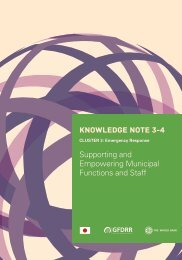
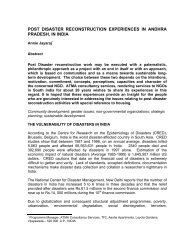
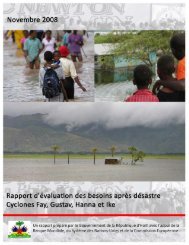
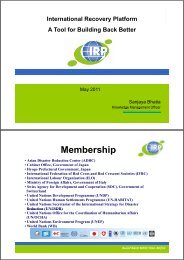
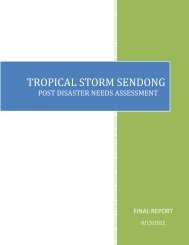
![View full document [PDF 7.65 MB] - unisdr](https://img.yumpu.com/48902806/1/178x260/view-full-document-pdf-765-mb-unisdr.jpg?quality=85)
